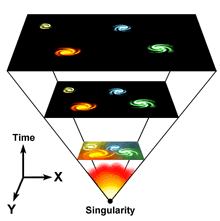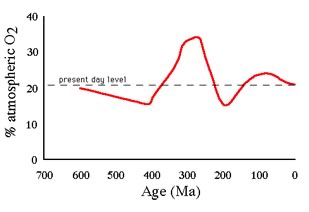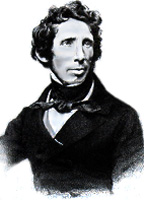| 2. Life's Origins |
Where did the different types of organisms now living on earth come from? This is one of the fundamental questions that biology attempts to answer. Did organisms arise at one specific time point, or have different types of organisms appeared at different times during the history |
 |
It used to be widely believed [link] that various types of organisms, such as flies, frogs, and even mice, arose spontaneously, from non-living matter. Flies, for example, were thought to appear from rotting flesh and mice from wheat. If true, on-going spontaneous generation would have profound implications for our understanding of biological systems. A key event in the conceptual development of modern biology was the publication in 1668 of Francesco Redi's "Experiments on the generation of insects". He hypothesized that spontaneous generation did not occur and that the organisms that appeared had developed from "seeds" deposited by adults. |
His hypothesis predicted that if adult flies were kept away from rotting meat, for example, maggots would not appear - no matter how long one waited. To test this hypothesis, Redi set up two sets of flasks - both contained meat. One set was exposed directly to the air (and so to flies), the other was sealed with paper or cloth. |
Maggots appeared only in the flasks open to the air. Redi concluded that organisms as complex as insects could arise only from other insects. The invention of the microscope, and its application to biological materials by Antony van Leeuwenhoek (1632-1723) and Robert Hooke (1635-1703), led to the discovery of a completely new (and totally unexpected) world of microscopic organisms - the protozoa, microscopic fungi, bacteria, and archaea. |
A number of scientists began to explore the reproduction of microbes. Lazzaro Spallazani (1729-1799) showed that after a broth was boiled, it remained sterile (that is, without life) as long as it was isolated from contact with fresh air. He concluded that microbes, like larger organisms, could not arise spontaneously, but were descended from other microbes (a version of the cell theory). |
Because of this scientific consensus, studying spontaneous generation was no longer considered a productive way to advance one's career in science. |
Questions to answer |
|
Question to ponder |
|
| The
origins of life in the universe:
Where
did the first organisms come from? To
begin to address this question, it is best to start at the beginning. The
current scientific model for the origin of the universe is known as
the "Big
Bang" theory. |
 |
Edwin Hubble (1889-1953) was the first to realize that the fuzzy nebula that astronomers saw through their telescopes were in fact galaxies, like our own Milky Way. Each was composed of many millions of stars. These galaxies appeared to be moving away from one another. He concluded that at one point in the past, all of the matter and energy in the universe must have been concentrated in a single point. Based on this hypothesis, it is possible to estimate the age of the universe at 13.7 +/- 0.2 billion (109) years. This is a length of time well beyond human comprehension; it is sometimes referred to as deep time. |
The earth and the other planets formed ~ 4.5 x 109 years ago. The earliest period of earth history is known as the Hadean, after Hades, the Greek god of the dead. The Hadean is defined as the period before the appearance of life. The first evidence of biological processes appear in rocks that are ~3.8 to 3.5 x 109 years. We do not know how many times life arose on the early earth, all we do know is that all of the current organisms we have studied are descended from a single common ancestor. |
Evidence of life: Fossils provide the most dramatic evidence of the history of life on earth. Fossils are formed only in sedimentary rock. There are a Chemical fossils are molecules that, as far as we know, occur in naturally only through biological processes. Their presence in ancient rock implies that living organisms were present at the time the rock was formed. What makes chemical fossils problematic is that there may be non-biological mechanisms that could produce them, but which we have yet to discover. |
Trace fossils can be subtle or obvious. Burrowing animals can leave tunnels and disrupt layers of sediment. Animals that walk can leave footprints. Organisms without hard parts, such as jellyfish, can leave impressions, much like footprints. Dinotracks at Dinosaur Ridge, in Morrison, Colorado |
| Structural fossils are the mineralized remains of organisms. More often than not a dead organism is eaten, and nothing recognizable remains. Occasionally an organism's remains are buried before they are destroyed. This can lead to fossilization, which involves replacing the organic materials with minerals. Over the billions of years that life has existed on earth, many fossils have been created; as erosion removes surface layers of rock, these fossils come to light. A fossil can be as simple as a single tooth, scale or shell, or as complex as a complete skeleton. As organisms developed hard parts, such as bones, teeth, and shells, fossilization became more likely. |
|
|
Life's impacts: Based on fossil evidence, it would appear that for a period of ~2 x 109 years, microscopic organisms were the only form of life on earth. |
During this period, photosynthetic bacteria captured light and used that energy to drive the reaction by which CO2 (carbon dioxide) and H2O (water) are combined to form sugars (carbohydrates). In the course of these reactions molecular oxygen (O2) was produced as a waste product. Over time O2 began to accumulate in the atmosphere. By about 300 million years ago, atmospheric O2 levels had reached ~35%, almost twice the current level. Some hypothesize that it was these high levels of atmospheric O2 that made possible the evolution of giant flying insects. Because O2 is
a highly reactive and potentially toxic compound, its appearance posed challenges
and provided opportunities to many organisms. |
  |
Around 109 years ago trace fossil burrows appeared; these were likely to have been produced by simple worm-like, macroscopic (meaning larger) metazoans (meaning multicellular animals) moving along and through the mud on the ocean floor. About 600 x 106 years ago, new, more complex structural fossils begin to appear in the fossil record. The first of these were the Ediacaran organisms. It remains unclear how they are related to later organisms. By the beginning of the Cambrian age (545 x 106 years ago), a wide variety of organisms had appeared, many clearly related to modern organisms. These Cambrian organisms show a range of body types. Most significantly, many were armored, suggesting the value of adaptations against predators. Since the fossil record does not contain all types of organisms, we are left to speculate on what the earliest metazoans looked like. |
Questions to answer
|
|
Questions to ponder |
|
| Understanding origins: There are at least three possible approaches to the study of life's origins. A religious (i.e. non-scientific) approach postulates that life was created by a supernatural being or process. Different religious traditions differ as to the details of this event, but since the process is supernatural it cannot, by definition, be studied scientifically. Nevertheless, "intelligent design" creationists claim that we can identify those aspects of life that could not have been produced by natural processes, by which they mean the processes of evolution. This approach abandons science, and displays a failure of faith in the creative power of natural processes, as well as in our ability to discover and understand them. More significantly, it implies that the origins of life are, by definition, beyond the ability of science to study. The lesson of history, however, is different. Predictions as to what is "beyond the ability of science to explain" have consistently been demonstrated to be wrong, often only a few years after they are made! |
| Another type of explanation would be to assume that advanced aliens brought life to earth. This hypothesis is termed panspermia. Perhaps we owe our origins to casually discarded litter from alien visitors. Unfortunately, this does not really answer the question of how life began, since those aliens also had to come from somewhere. |
If there is life on other planets, and we could analyze it, it would be extremely informative to know how similar it is to life on earth. Are the same types of molecules used? Is DNA used to store genetic information? If it is very different, would we even recognize it as being alive? Unfortunately, it is currently not yet possible (and unlikely to become possible) to answer these questions. While "earth-like" planets continue to be discovered, we really have no idea whether life is common or rare (in the universe). The most likely scenario for discovering independent origins of life would be to look at planets and moons in our solar system [link][Darwin IV alien planet video]. |
The death of vitalism: It was originally thought that life itself was a type of supernatural process, too complex to obey (or be understood through) the laws of chemistry and physics. In this "vitalistic" view, organisms were thought to obey different laws from the "non-living" world. For example, it was widely held that the molecules found in living organisms, known as organic molecules, could not be made except by living organisms. |
 |
This view was challenged when Friedrich Wöhler synthesized urea in the lab in 1828. Urea is a simple organic molecule. O=C(NH2)2. It is naturally found only in living organisms and is a major waste product. Urine contains lots of urea. Wöhler's in vitro or "in glass" synthesis of urea was simple. He took the inorganic compound ammonium cyanate (NH4+CNO-) and heated it; this led to the production of urea. |
While simple, the synthesis of urea had a profound impact – it revealed that there was nothing supernatural about the synthesis of urea; it obeyed the laws of chemistry. Based on this and similar observations, we (that is, scientists) are now comfortable with the idea that all molecules in cells can, in theory at least, be synthesized outside of cells, using the appropriate procedures. This is very much the same approach that scientists use when they consider the question of how life first arose. They assume that life is a natural process, and that with time, the steps involved could be recapitulated in the lab. |
"It is often said that all
the conditions for the first production of living organisms are
now present. But
if (and oh! what a big if!) we could conceive in some warm little
pond, with all sorts of ammonia and phosphoric salts, light,
heat, electricity, etc. present, that a proteine compound was
formed, ready to undergo still more complex changes, at the present
day such matter would be instantly devoured or absorbed, which
would not have been the case before living creatures were formed." - Charles Darwin (1887). |
One approach to understanding what is involved in the origin of life is to attempt to create the precursors of living systems in the laboratory. An early and influential example of this approach was the Miller-Urey experiment. These two scientists made a guess as to the composition of earth's early atmosphere. They assumed the presence of oceans and lightning. They set up an apparatus to mimic these conditions. They passed electricity through their experimental atmosphere. After awhile (hours/days), they found that a complex mix of compounds had formed. Included in this mix were many different types of amino acids. |
Certain types of meteorites also contain complex organic molecules. It therefore appears likely that the early earth was rich in organic (that is, carbon-containing) molecules, the building blocks of life. Given that the potential building blocks were present, the question is, what set of steps were involved in generating living systems? The earliest proto-biotic systems were likely to be molecular communities of chemical reactions isolated in some way from the rest of the "outside" world. One possible model is that such systems were originally associated with the surface of specific minerals, which served as catalysts for important reactions. |
Over time, these systems acquired membranes and were able to exist free of the mineral surface. Such an isolated system has important properties that are likely to have facilitated the further development of life. For example, because of the membrane boundary, changes that occur within one such structure will not be "shared" with neighboring systems, they can accumulate and favor the "survival" of one system over its neighbors. |
Such systems can also "divide" in a crude way by fragmentation. If changes within one such system improves its stability, its ability to accumulate resources, or its ability to survive and reproduce, that system, and its progeny, are likely to become more common. |
| As changes accumulate, and are passed from parent to offspring, the "organisms" will evolve. |
Questions to answer |
|
Questions to ponder |
|
before class [ talk amongst yourselves about the questions] |
| replace with revised beSocratic activity |
Tweet
10-May-2014
|